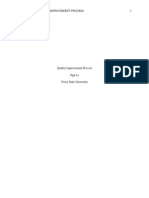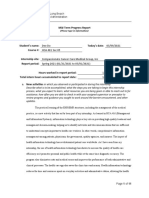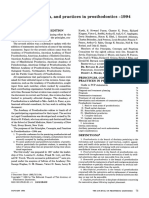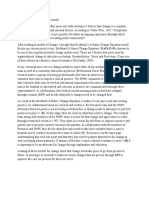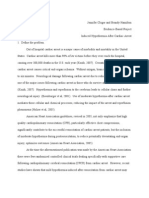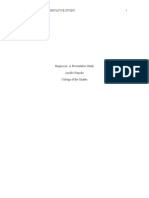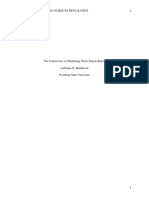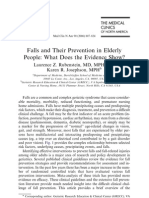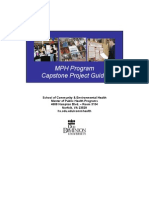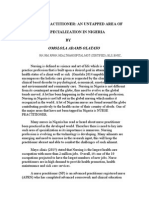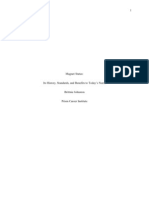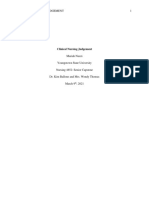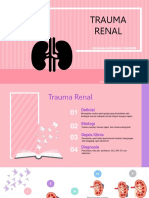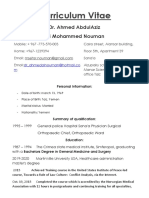Nurs 350 Pico Paper, Spring 2014
Nurs 350 Pico Paper, Spring 2014
Uploaded by
api-253664398Original Description:
Original Title
Copyright
Available Formats
Share this document
Did you find this document useful?
Is this content inappropriate?
Report this DocumentCopyright:
Available Formats
Nurs 350 Pico Paper, Spring 2014
Nurs 350 Pico Paper, Spring 2014
Uploaded by
api-253664398Copyright:
Available Formats
Running head: THE NEED FOR PAIN RESOURCE NURSES
The Need for Pain Resource Nurses
Nga Le
Ferris State University
Abstract
As the complexity and challenges of analgesic therapy continues to increase, it is the duty of the
nurse to question, critique and implement an intervention designed to improve the assessment
and management of pain. This ensures quality and safe care to patients, and is also feasible to
both the patient and the hospital. The purpose of this literature review is to examine and
question current practice for the need of nurse-led, patient-centered care, such as a resource nurse
that manages pain, more specifically, postoperative pain. Three research articles were assessed,
studied and reviewed. It was found that the literature encourages the utilization of a pain
resource nurse (PRN) in pain management. PRN is becoming the innovative method to enhance
current evidence-base knowledge of pain, its assessment, and management. Furthermore, the
THE NEED FOR PAIN RESOURCE NURSES
role of the PRN is to be the go-to-nurse for pain related issues, instill confidence and empower
fellow nurses to step up and effectively advocate for patients who are in pain, and to improve
practice behavior among nurses, physicians, and the disciplinary team.
The Need for Pain Resource Nurses
Evidence base practice (EBP) is the hallmark of excellence that supports and drives
nursing practice. However, research continues to show nurses main barriers are the lack of
knowledge and understanding of pain management, which prevents them from providing
satisfactory pain control (Grant, Ferrell, Hanson, Sun, & Uman, 2011). The purpose of this
literature review is to motivate and encourage nurses to explore and question clinical decisions in
an effort to improve and construct evidence-based solutions to change and enhance current
patterns of practices and thinking. To examine the need of nurse-led, patient-centered nursing
care, such as a resource nurse in managing pain, more specifically, postoperative pain.
Clinical Question
THE NEED FOR PAIN RESOURCE NURSES
In the hectic work cultures of todays nurses, there is the ever-increasing demands for
expertise, experience and higher evidence-based practices that tailors to patients specific needs,
beliefs, values, and preferences. This practice proves to be difficult at times on the orthopedic
floor, where pain management is greatly stressed upon in postoperative patients. Pain can
diminish a patients ability to participate in postoperative care and interventions such as ankle
pumps, cough and deep breathing, and working with therapy. In the reviewing of literature, it
was reported that in this current time era, pain management and the application of pain
assessment continues to be challenging for many nurses (Francis & Fitzpatrick, 2013).
On the reflection and observation of this clinical and literature findings it is suggested
that current practice of pain management is not effective. Consequently, this issue prompted a
clinical research question that addresses the problem regarding the lack of knowledge in pain
management. A PICOT format that was developed by Fineout-Overholt and Johnston was used
to format this clinical specific question. The acronym PICOT, stands for patient/population (P),
intervention/interest area (I), comparison intervention/current practice (C), outcome desired (O),
and the time to achieve outcome (T, optional) (Nieswiadomy, 2012). Leading to the PICO
question itself: Do adult postoperative patients receive better pain control when utilizing a pain
resource nurse in comparison to not using one?
The answer to this PICO question can facilitate better understanding of nurses
postoperative pain assessment and management skills. Patients with adequate pain control are
less likely to experience postoperative complications such as: atelectasis and pneumonia, deep
vein thrombosis (DVT), and muscle loss with inactivity which can contribute to bed sores and
prolong hospital stay. Ultimately, nurses need to be aware and understand the pathophysiology
THE NEED FOR PAIN RESOURCE NURSES
and management of pain in order to successfully lead the efforts of change in delivering clinical
practice that enhances both the quality and safety of patient care.
Methodology
The methodology used to search for knowledge and evidence in answering to the PICO
question was through literature review via Ferris State online library search engines such as:
CINAHL, PubMed, and the Cochrane Library. Content sources were analyzed and critiqued for
sound evidence through the literature studies of three articles. Keywords were pain resource
nurse, postoperative, and assessment.
EBP is known as the unique body of knowledge that stems from nursing research, and in
turn serves as the foundation to guide nursing practice. In defending the exclusion criteria
regarding nursing as a profession, nurses are encouraged to clinically critique and question their
practice, promoting changes with sound evidence-based research to redesign care that is
effective, efficient, and safe in maintaining its professional credibility (Nieswiadomy, 2012). In
short, nurses have the responsibility to engage in research and to contribute and enhance existing
knowledge. In order for nursing specific changes to take place, the evidence-based research
needs to be author or directed by nursing. Similarly, who else knows nursing better than nurses?
When talking about EBP and credibility, it is important for research nurses to be aware
that not all research studies are of sound evidence (Armola et al., 2009). With the tremendous
emphasis of the evidence evaluation issue, the American Association of Critical-Care Nurses
(AACN) scale was developed (Armola et al., 2009). Nursing practitioners utilize the evidence
ranking system with the assessment of certain evidence criteria such as if the study was peerreviewed, if it is a random trial or case control study, or if it is a systematic review. The ranking
system is comprised of six levels, level M being the lowest level of evidence which only has
THE NEED FOR PAIN RESOURCE NURSES
manufacturers recommendations, and level A as the highest level of evidence, with evidence that
derives from meta-analysis of multiple controlled trails or meta-synthesis of qualitative studies
(Armola et al., 2009). The Quality and Safety in Nursing (QSEN) scale is another levels of
evidence that is being utilized other than the AACN scale. Therefore, it is crucial to note and
make record of what scale is being used to measure evidence.
Discussion of Literature
Article one
The refereed article titled, The Enduring Need for the Pain Resource Nurse (PRN)
Training Program is an online publication by Springer Science+Business Media, which is
affiliated with Nursing Research & Education, Department of Population Sciences, City of Hope
(Grant et al., 2011, p. 598). Impact factor of 0.880 (Springer, 2012). This study best fits the
AACN evidence Level E, for it is theory-based evidence (Armola et al., 2009). No ethical
approval noted. The purpose of the study was clearly identified: evaluating the long-term effect
of the PRN program on nursing pain monitoring (Grant et al., 201). There were 33 references
that dated from 1990-2011, consisting of both classic and current sources.
Furthermore, the design was a pretest-posttest control group, with convenient sample that
consisted of 180 participants who attended the PRN program (Grant et al., 2011). Internal
threats to validity include reactive effects of the pretest and mortality because of the possibility
of subjects pretest sensitization and that initially, 783 participants began the study and only 180
completed the study (Grant et al., 2011). The statistical analysis was difficult to understand, but
it did appear that the paired t tests with the ratio level of measurement were appropriately
utilized. The study results were clearly stated, affirming that nurses are the key player in
advocating for the PRN program to optimally improve pain management in patients.
THE NEED FOR PAIN RESOURCE NURSES
Article two
Article two titled, Evaluating the Feasibility and Effect of Using a Hospital-Wide
Coordinated Approach to Introduce Evidence-Based Changes for Pain Management is a peerreviewed journal that deliver a unique focus on pain management that is specific to nursing, and
is author by nurses (Williams et al., 2012). Impact factor of 1.696 (Reuters, 2013). This study
best fits the AACN evidence Level D, for it is reviewed, with clinically supported studies and
recommendations (Armola et al., 2009). The pilot study framework of this research was a model
for changing clinical practice in acute-care setting, consisting of both quantitative and qualitative
measures was ethically approved by Curtin University of Technology as well as each of the
hospital involved (Williams et al., 2012). The purpose of the study was clearly identified, aiming
to explore the usefulness, feasibility and effect of implementing a new model of change by
incorporating PRNs hospital-wide with the purpose to improve the management of pain
(Williams et al., 2012). There were 27 references that dated from 1990-2008, consisting of both
classic and current sources.
Additionally, the study purposive sample consisted of 30 PRNs that took the role of
clinical pain champions (Williams et al., 2012). Internal threats to validity include testing and
instrumentation change stemming from the possibility of subject retained knowledge from the
pretest and that the data results may not be accurately measured because of tool revision that was
done for the study (Nieswiadomy, 2012). The study appeared comprised of ordinal, interval, and
ratio levels of measurement. Moreover, the qualitative and quantitative data, along with
knowledge and attitudes of the PRNs were measured and analyzed with the use of Statistical
Package for the Social Sciences (SPSS), Ferrell and McCafferys, Cronbach alpha coefficient,
the chi-square analysis, t test, and Mann-Whitney test (Williams et al., 2012). The study results
THE NEED FOR PAIN RESOURCE NURSES
were clearly stated, supporting the findings that found the implementation and incorporation of
PRNs proved to be usefulness, feasible and effective in improving the management of pain
(Williams et al., 2012).
Article three
Article three titled, Postoperative Pain: Nurses Knowledge and Patients Experiences is
a peer-reviewed journal that deliver a unique focus on pain management that is specific to
nursing, and is author by nurses (Williams et al., 2012). Impact factor of 1.696 (Reuters, 2013).
This study best fits the AACN evidence Level D also, for it is reviewed with clinically supported
studies and recommendations (Armola et al., 2009). The research was approved by the
Institutional Review Board (Francis & Fitzpatrick, 2013). The purpose of the study was clearly
identified, aiming to explore nurses pain perceptions and knowledge of postoperative patients
pain experiences. There were 18 references that dated from 1975-2011, appropriately consist of
both classic and current sources.
Furthermore, the research was a pilot study with a descriptive exploratory design
conducted at a teaching hospital, with a convenient sample that consisted of 31 nurses from
gastrointestinal and urologic specialties with ages ranged from 22 to 62 years and selection of
patients who spoke and understood English with age ranged from 28 to 71 years (Francis &
Fitzpatrick, 2013). Internal threats to validity include the Hawthorne effect where the patients
may respond in a certain manner when being observed or question, along with instrumentation
change in regards to the type of procedure done and the type of analgesic administered during the
surgery (Nieswiadomy, 2012). The statistical analysis was difficult to make clear of. However, it
did appear that the nominal, ordinal, and interval level of measurement data were measure with
the Short-Form McGill pain Questionnaire, visual analog scale, demographic questionnaire,
THE NEED FOR PAIN RESOURCE NURSES
Quality Indicators in Postoperative Pain Management questionnaire, along with the Knowledge
and Attitudes Survey Regarding Pain (Francis & Fitzpatrick, 2013). The study results were
clearly stated, confirming the need to employ a multidisciplinary evidence-based program such
as the PRN program to assist with provision and management of patients postoperative pain.
Significance to Nursing
QSEN define quality and safety competencies comprises of evidence-based practice,
quality improvement, patient-centered care, safety, and informatics (QSEN Institute, 2014).
Furthermore, the topic of integrating evidence-based practice is not aim to simply enrich quality
and safe care practices, but to also instill nurses with knowledge, skills and attitudes (KSAs)
needed to continuously push the limit in improving quality safe care (QSEN Institute, 2014).
Additionally, the American Nurses Association (ANA) (2010), what clinically guides a
professional nurse is the Standards of Practice and Standards of Professional Performance. The
nursing Standards of Practice is directed by critical thinking model such as the nursing process
are unknowing utilized by nurses every day. The nursing process encompasses components of
assessment, diagnosis, outcomes identification, planning, implementation, and evaluation (ANA,
2010). Whereas, the Standards of Professional Performance focus more on the behavioral and
the professional role of nursing, such as ethics, education, evidence-based practice and research,
quality of practice, communication, leadership, collaboration, professional practice evaluation,
and environmental health (ANA, 2010). Along with the components from the Standards of
Practice and Standards of Professional Performance, nursing standard 9 and 10 further supports
the integration of evidence-based research finding in contributing to clinical inquires of todays
current scientific knowledge in providing safe quality nursing practice (ANA, 2010).
THE NEED FOR PAIN RESOURCE NURSES
The formation of the PICO question and the integration of that evidence into practice
utilize the very same consideration from Standards of Practice and Standards of Professional
Performance. For example, nurses are encouraged to be observant and question ways to improve
nursing practices. Doing so, the nurse assesses the clinical situation, identifies that postoperative
patients pain is not effectively being managed. Leading to the PICO question itself: Do adult
postoperative patients receive better pain control when utilizing a pain resource nurse in
comparison to not using one? Following that step would be to critically think and identify
expected outcomes that will provide patients with adequate pain control. After that research is
done to support expected outcome. The next step would be planning of strategies to reach that
outcome, leading to action of integrating evidence-based research into practice, where the
integration of the PRN program is put into practice. Evaluation may be the last step of the
nursing process, but the evaluation process happens throughout each component of the nursing
process. Through all the critical planning, researching, implementing, and evaluating;
professional standards are ethically upheld.
In consideration of professional values, healthcare policy, and available of resources, the
integration of the PRN program will not only improve pain management practices and
minimizing postoperative complications, but will be feasibly effective in promoting quality and
safe care in pain stricken patients. Poor management of postoperative pain could be a
detrimental setback to patients outcome. Pain can diminish a patients ability to participate in
postoperative care and interventions such as ankle pumps, cough and deep breathing,
ambulating, and working with therapy. Leading to atelectasis and hospital acquired pneumonia,
deep vein thrombosis (DVT), profound deconditioning due to muscle loss with inactivity which
can contribute to bed sores and other hospital acquired diseases, which may prolong their
THE NEED FOR PAIN RESOURCE NURSES
10
hospital stay. According to the CDC prevalence survey of hospital acquired infections (HAIs) in
the United States (U.S.) hospitals, it is estimated that there were 722,000 cases of HAIs in 2011,
costing the U.S. health care system tens of billions dollars a year (Centers for Disease Control
and Prevention [CDC], 2014). All-in-all, research evidence repeatedly show nurses lack the
knowledge and understanding of pain management. In attempt to offset of postoperative
complications and HAIs prevention, literature research was done. It was found that research
evidence encourages the utilization of a pain resource nurse (PRN) in pain management as PRNs
are becoming the innovative method to enhance current evidence-base knowledge of pain, its
assessment, and management. Moreover, the role of the PRN is to provide leadership, be the goto-nurse for pain related issues, instill confidence and empower fellow nurses to step up and
effectively advocate for patients who are in pain, and to improve practice behavior among
nurses, physicians, and the disciplinary team.
THE NEED FOR PAIN RESOURCE NURSES
11
References
American Nurses Association (ANA). (2010). Nursing: Scope and Standard of Practice (2 ed.).
Silver Spring, Maryland: Nursesbooks.org.
Armola, R. R., Bourgault, A. M., Halm, M. A., Board, R. M., Harrington, L., Heafey, C. A.
Medina, J. (2009). AACN Levels of Evidence: Whats New? CriticalCareNurse, 29, 7073. http://dx.doi.org/10.4037/ccn2009969
Centers for Disease Control and Prevention. (2014). Healthcare-Associated Infections (HAIs).
Retrieved from http://www.cdc.gov/HAI/surveillance/index.html
Francis, L., & Fitzpatrick, J. J. (2013, December). Postoperative Pain: Nurses Knowledge and
Patients Experiences. Pain Management Nursing, 14, 351-357.
http://dx.doi.org/10.1016/j.pmn.2012.05.002
Grant, M., Ferrell, B., Hanson, J., Sun, V., & Uman, G. (2011, August 25). The Enduring Need
for the Pain Resource Nurse (PRN) Training Program. Journal of Cancer Education, 598603. http://dx.doi.org/10.1007/s13187-011-0268-1
Nieswiadomy, R. M. (2012). Evidence-Based Nursing Practice. In Foundations of Nursing
Research (6 ed. (p. 282). One Lake Street, Upper Saddle River, New Jersey: Pearson
Education.
QSEN, . (2014). QSEN. In QSEN Institute . Retrieved March from http://qsen.org/about-qsen/
Reuters, Thomson. "Pain Management Nursing." Pain Management Nursing. Ed. Thomson
Reuter. Elsevier, 2014. Web. 21 Mar. 2015. <http://www.painmanagementnursing.org/>.
Springer. (2013). Journal of Cancer Education. In Springer. Retrieved from
http://www.springer.com/biomed/cancer/journal/13187
THE NEED FOR PAIN RESOURCE NURSES
12
Williams, A. M., Toye, C., Deas, K., Fairclough, D., Curro, K., & Oldham, L. (2012, December).
Evaluating the Feasibility and Effect of Using a Hospital-Wide Coordinated Approach to
Introduce Evidence-Based Changes for Pain Management. Pain Management Nursing, 4,
202-214. http://dx.doi.org/10.1016/j.pmn.2010.08.001
You might also like
- Nurs 603 Assignment 2Document6 pagesNurs 603 Assignment 2api-429205355No ratings yet
- NURS 270 Midterm #1 Blueprint ReviewDocument25 pagesNURS 270 Midterm #1 Blueprint ReviewAgajddNo ratings yet
- Sentence Outline Africa HypertensionggeneDocument2 pagesSentence Outline Africa HypertensionggeneYzel Senining100% (3)
- Nurs 440, Quality Improvement Process Paper, Fall 2014Document8 pagesNurs 440, Quality Improvement Process Paper, Fall 2014api-253664398No ratings yet
- Running Head: Evidence-Based Practice: Pressure Ulcer RiskDocument5 pagesRunning Head: Evidence-Based Practice: Pressure Ulcer RiskElise HowardNo ratings yet
- Nurs 250 (460) Course OutlineDocument28 pagesNurs 250 (460) Course Outlineapi-284023932No ratings yet
- Nur420 Policy Action PlanDocument7 pagesNur420 Policy Action Planapi-449016971No ratings yet
- Final Hca 481 Internship Report 1 3Document11 pagesFinal Hca 481 Internship Report 1 3api-535414037No ratings yet
- Recommended Topics For PCORI Research On Multiple Chronic ConditionsDocument3 pagesRecommended Topics For PCORI Research On Multiple Chronic ConditionsPartnership to Fight Chronic DiseaseNo ratings yet
- Nurs 604 Learning Contract Edited For WeebleyDocument10 pagesNurs 604 Learning Contract Edited For Weebleyapi-3231693450% (1)
- Final EvaluationDocument10 pagesFinal Evaluationapi-338285420No ratings yet
- Week 10 Assignment - EditedDocument6 pagesWeek 10 Assignment - EditedHugoNo ratings yet
- Huang Et Al-2014-Journal of Clinical Nursing PDFDocument11 pagesHuang Et Al-2014-Journal of Clinical Nursing PDFSanta Maria PangaribuanNo ratings yet
- Academy of Prosthodontics - Principles Concepts and Practices in Prosthodontics PDFDocument22 pagesAcademy of Prosthodontics - Principles Concepts and Practices in Prosthodontics PDFValonia IreneNo ratings yet
- The COAT & Review Approach: How to recognise and manage unwell patientsFrom EverandThe COAT & Review Approach: How to recognise and manage unwell patientsRating: 5 out of 5 stars5/5 (1)
- Recognition of PerceptorDocument7 pagesRecognition of PerceptorzakyNo ratings yet
- Nurses' Six Rights For Safe Medication Administration: by Michelle Colleran CookDocument4 pagesNurses' Six Rights For Safe Medication Administration: by Michelle Colleran CookJosephmeledathu RobinNo ratings yet
- Nurs 440 Change ModelDocument2 pagesNurs 440 Change Modelapi-249918909No ratings yet
- Essential IV - Nurs 404Document6 pagesEssential IV - Nurs 404api-385640092No ratings yet
- John Hopkins Evidence Table - Systematic ReviewDocument2 pagesJohn Hopkins Evidence Table - Systematic Reviewsandy ThylsNo ratings yet
- Eval GuideDocument92 pagesEval GuideJason BrownNo ratings yet
- EBP Paper FinalDocument5 pagesEBP Paper FinalBrittney Dunn100% (1)
- Nurs 2200 Asthma Case StudyDocument6 pagesNurs 2200 Asthma Case StudyBrandee StantonNo ratings yet
- Biostat Quiz LeakDocument3 pagesBiostat Quiz Leakkylepeps50% (2)
- Running Head: LITERATURE REVIEW 1Document23 pagesRunning Head: LITERATURE REVIEW 1api-404271262No ratings yet
- Nurse Manager Interview and AnalysisDocument7 pagesNurse Manager Interview and Analysisapi-284683257No ratings yet
- EBP PaperDocument7 pagesEBP PaperTyler Francke100% (2)
- Final Evaluation Nurs 2020-5Document9 pagesFinal Evaluation Nurs 2020-5api-313097878No ratings yet
- 11 24 19 Nur 403 Final Practice Summary PaperDocument14 pages11 24 19 Nur 403 Final Practice Summary Paperapi-488513754No ratings yet
- Healing of UsaDocument3 pagesHealing of Usaapi-237353755No ratings yet
- Clinical Judgement Paper - CapstoneDocument5 pagesClinical Judgement Paper - Capstoneapi-507853880No ratings yet
- Nurs403 Complete Issue AnalysisDocument12 pagesNurs403 Complete Issue Analysisldhenderson100% (1)
- Sonu Scaria Literature ReviewDocument13 pagesSonu Scaria Literature ReviewAnonymous aUrycuWgyNo ratings yet
- Nurs 300 - Disease BrochureDocument2 pagesNurs 300 - Disease Brochureapi-224141758No ratings yet
- Falls and Their Prevention in Elderly People: What Does The Evidence Show?Document18 pagesFalls and Their Prevention in Elderly People: What Does The Evidence Show?Purvi NandaniNo ratings yet
- Qsen Paper-SubmittedDocument7 pagesQsen Paper-Submittedapi-396919069No ratings yet
- Introduction To The Public Health ApproachDocument64 pagesIntroduction To The Public Health ApproachMiguel MansillaNo ratings yet
- Literature ReviewDocument8 pagesLiterature ReviewAmie Rha-Phicezzy100% (1)
- MPH Capstone GuideDocument17 pagesMPH Capstone GuideImran KhanNo ratings yet
- Hat Is A Preceptorship: HapterDocument6 pagesHat Is A Preceptorship: HapterAmeng GosimNo ratings yet
- Leadershp Strategy Analysis Paper FinalDocument10 pagesLeadershp Strategy Analysis Paper Finalapi-240099055No ratings yet
- Problem-Based Research PaperDocument8 pagesProblem-Based Research Paperapi-457674200No ratings yet
- Nurse Practitioner: An Untapped Area of Specialization in NigeriaDocument5 pagesNurse Practitioner: An Untapped Area of Specialization in NigeriaOMOLOLA ADAMS OLATAYONo ratings yet
- Bekele ChakaDocument74 pagesBekele ChakaDoods QuemadaNo ratings yet
- Picot Synthesis SummativeDocument14 pagesPicot Synthesis Summativeapi-259394980No ratings yet
- Nurs 403 Practice Summary PaperDocument17 pagesNurs 403 Practice Summary Paperapi-369824515No ratings yet
- Observation Summary 2Document5 pagesObservation Summary 2api-493028287No ratings yet
- FesarahDocument8 pagesFesarahapi-271855323No ratings yet
- Nurs 125 Clinical ProjectDocument20 pagesNurs 125 Clinical ProjectMelissa100% (1)
- WHO/HPR/ AHE/98.2 English Only Distr: General: Oc P y Act - Pro 3 7 98Document25 pagesWHO/HPR/ AHE/98.2 English Only Distr: General: Oc P y Act - Pro 3 7 98indraardiiNo ratings yet
- Final Casa RehabDocument11 pagesFinal Casa Rehabapi-283970192No ratings yet
- Hemodialysis Thesis - Analytical EssayDocument4 pagesHemodialysis Thesis - Analytical EssayDianne LopezNo ratings yet
- Hypertension in Dialysis PatientsDocument16 pagesHypertension in Dialysis PatientsLiliana WoodNo ratings yet
- Nurs 603 Assignment 4 D StudentDocument10 pagesNurs 603 Assignment 4 D Studentapi-429205355No ratings yet
- Magnet StatusDocument10 pagesMagnet StatusBrittnie Johnston100% (1)
- Peripartum Cardiomyopathy: Adapted From SourceDocument37 pagesPeripartum Cardiomyopathy: Adapted From SourceSurgicalgownNo ratings yet
- StatementDocument5 pagesStatementtrinity_brannonNo ratings yet
- Assessment (Week 4)Document27 pagesAssessment (Week 4)mp1757No ratings yet
- Capstone Clinical Nursing JudgementDocument7 pagesCapstone Clinical Nursing Judgementapi-544889322No ratings yet
- Icu Delirium Final PaperDocument12 pagesIcu Delirium Final Paperapi-348346538No ratings yet
- Saint Paul University Philippines: Evidence-Based Practice ProposalDocument3 pagesSaint Paul University Philippines: Evidence-Based Practice ProposalBarbara CamuNo ratings yet
- Sandoz LTD Levofloxacin 500 MG Film-Coated Tablet: by Adeyanju Patrick at 4:19 PM, Sep 05, 2011Document8 pagesSandoz LTD Levofloxacin 500 MG Film-Coated Tablet: by Adeyanju Patrick at 4:19 PM, Sep 05, 2011afsala1982No ratings yet
- First Aid and Basic Life Support Training CourseDocument3 pagesFirst Aid and Basic Life Support Training CourseBfp Riva Morong RizalNo ratings yet
- Acute Coronary Syndrome: Patsadee Nachom MDDocument58 pagesAcute Coronary Syndrome: Patsadee Nachom MDRachapon OngwibunwongNo ratings yet
- Srikanth ReddyDocument160 pagesSrikanth ReddyrambhadesiNo ratings yet
- Traveller Public Health DeclarationDocument2 pagesTraveller Public Health DeclarationCorina-dianaDoduNo ratings yet
- Pemeriksaan Radiologi Pada Trauma GinjalDocument21 pagesPemeriksaan Radiologi Pada Trauma GinjalQotrunnada Alwi Zubaidah, S.KedNo ratings yet
- Monoclonal Antibody-Preparation & Application - MPH201TDocument21 pagesMonoclonal Antibody-Preparation & Application - MPH201TBasant DangiNo ratings yet
- Euthanasia Death With Dignity and The Law PDFDocument2 pagesEuthanasia Death With Dignity and The Law PDFJerryNo ratings yet
- Prevalence of Human Papillomavirus in Indonesia: A Population-Based Study in Three RegionsDocument6 pagesPrevalence of Human Papillomavirus in Indonesia: A Population-Based Study in Three RegionsIlvita MayasariNo ratings yet
- JurnalDocument5 pagesJurnalmira ariantiNo ratings yet
- Drug Eluting Stents and Bare Metal StentsDocument21 pagesDrug Eluting Stents and Bare Metal StentsVlorent Anggi Dk0% (1)
- Discharge PlanDocument4 pagesDischarge PlanryanNo ratings yet
- Rachel Sedgwick ResumeDocument1 pageRachel Sedgwick Resumeapi-276959129No ratings yet
- Proposal Sponsorship Spora EnglishDocument29 pagesProposal Sponsorship Spora EnglishVindy CesarianaNo ratings yet
- Drugs For Cough and Bronchial AsthmaDocument47 pagesDrugs For Cough and Bronchial AsthmaNavlika DuttaNo ratings yet
- 3 - RN3 Networks AugustDocument200 pages3 - RN3 Networks AugustSereenaNo ratings yet
- MS Gi4Document2 pagesMS Gi4Amiel Francisco ReyesNo ratings yet
- Block 1Document24 pagesBlock 1AbANo ratings yet
- Lesson 7. Education, Religion, Belief System and Health - StudentDocument49 pagesLesson 7. Education, Religion, Belief System and Health - StudentAhyessa Castillo100% (1)
- MALARIA DR - PAULDocument67 pagesMALARIA DR - PAULNodi Rahma DiniNo ratings yet
- History of RabiesDocument23 pagesHistory of Rabiescolicot100No ratings yet
- Kat157 PDFDocument50 pagesKat157 PDFandynightmare97No ratings yet
- Dr. Ahmed Curriculum 2019Document9 pagesDr. Ahmed Curriculum 2019Dr.Ahmed AlnoumanNo ratings yet
- Bruxism Defined and Graded: An International ConsensusDocument3 pagesBruxism Defined and Graded: An International ConsensusCésar LeónNo ratings yet
- Soal Latihan Pas Kelas 11 NewDocument20 pagesSoal Latihan Pas Kelas 11 NewerninanovitaNo ratings yet
- Essential Newborn CareDocument40 pagesEssential Newborn CareHero Mondares100% (1)
- Dent Pain Management: Developments inDocument18 pagesDent Pain Management: Developments inCaglarBursa100% (1)
- Insights and Images: Vascular Channel Mimicking A Skull FractureDocument2 pagesInsights and Images: Vascular Channel Mimicking A Skull Fracturethariq mubarakNo ratings yet



